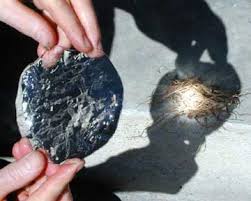A spoon in a glass of water appears not only broken, but also larger. The shape of the transparent medium transforms the image by light refraction. With the right shape it may increase or decrease. Glass lenses do so. Water, in the right form, also. You can also cut lenses, scratch or melt them of clear ice.
 Gardeners say that it is not wise to water plants when it is hot, because then the leaves burn. Scientists confirm: water droplets behave like little magnifying glasses.
Gardeners say that it is not wise to water plants when it is hot, because then the leaves burn. Scientists confirm: water droplets behave like little magnifying glasses.
Blades with a smooth surface not get burns from water droplets. On a sheet with tiny hairs the droplet remains on the hair. The space between the drop and leaf makes the sunlight can focus on the leaf. This could cause a burn (and even occur a forest fire).
You can use the surface tension of water, and the round shape of the drop to make a loupe. Take a thin, non-absorbent plate (tin, bone, slate...) and drill a round hole. Make the hole not too large, or the droplet falls out. About 5 mm is good. Not too small, or you see nothing.
Put a drop of water in the hole. Which acts as a magnifying glass. Find the correct object distance (1 cm) and provide sufficient light. Do not expect a great and stable image. You will need some searching and experimenting.
The oldest lenses were semicircular pieces of crystal or gemstone (beryl quartz). One of rock crystal from 640 BC was found in Nineveh (Mosul, Iraq). Ibn Sahl wrote in 984 already ‘About burning mirrors and lenses’.
The ancient Greeks used a convex vase or bottle filled with clear water to concentrate sunlight. They would ignite temple fires with it and cauterize wounds.
In the Herakleion Museum (Crete) are lenses of quartz, with a flat and a convex side, 22 mm diameter, dated around 1500 BC.
The Vikings had a thousand years ago, professionally, perfect bi - spherical polished lenses cut from rock crystal. The most beautiful Visby lens has a diameter of five centimeters and a thickness of three centimeters.
Amber can be so polished (with wood )that it is transparent (but not bright).
Nimrud's lens is a 3,000-year-old rock crystal object that Sir John Layard found in 1850 in Iraq's Assyrian Nimrud Palace. It is dated between 750 and 710 BC. and magnifies 3 times.
The oldest lenses date from about 4,500 years ago (4th and 5th Dynasty of Ancient Egypt). There are beautiful specimens (eg 'Le Scribe Accroupi' and ‘the Kai' in the Louvre), which are believed to have been used as eye structures (iris / pupil inserts) for grave statues.
The children of Hans Lippershey (1570-1619) would have discovered playing with concave lenses of father optician that they saw the the church tower increased, with one lens on their nose, and the other at arm's length. The Dutchman (there are three other contenders for the invention) would have the lenses mounted in a tube to create a telescope. Zacharias and Hans Jansen turned it around and assembled a microscope.
A Dutch telescope lens (opera glasses) uses a positive lens (in the middle thicker) as objective and as a negative lens (diverging) eyepiece. Kepler developed a variant with a positive (converging) eyepiece so that the angle is larger, but the image is upside down. Later reversing prisms were added.
Binoculars enlarge 8 times, but when I used it the 9th time, they just did it.
